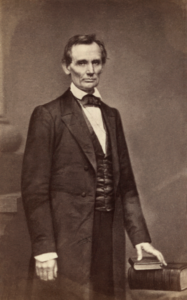 On January 5, 1858, Abraham Lincoln wrote to Robert A. Kinzie of Chicago regarding the case of Johnston v. Jones and Marsh, commonly called the Sand Bar Case. The case was revealing because, in an age where trial transcripts were almost never kept, journalist Robert Hitt was paid to sit through the entire trial and create a comprehensive 482-page trial transcript, although he omitted the closing arguments.
On January 5, 1858, Abraham Lincoln wrote to Robert A. Kinzie of Chicago regarding the case of Johnston v. Jones and Marsh, commonly called the Sand Bar Case. The case was revealing because, in an age where trial transcripts were almost never kept, journalist Robert Hitt was paid to sit through the entire trial and create a comprehensive 482-page trial transcript, although he omitted the closing arguments.
The case revolved around the accretion of new land created by various efforts to turn Lake Michigan’s shoreline at Chicago into a practical harbor, something nature had not designed it to do. Channels were dug, piers were built, and a great deal of sand was dredged. Eventually, Chicago had a harbor. In 1833, the government cut a channel across lakefront lots owned separately by William Johnston and William Jones. A newly erected pier caused the accretion of nearly 1,200 feet of new land, roughly six acres, which both Johnston and Jones claimed as their own. After four trials, the last of which found for Johnston, Jones appealed to the Supreme Court, which reversed the judgment and sent it back to the lower courts. At this point, Jones retained Lincoln while Johnston had retained Kinzie.
A legal colleague, while not specifically talking about the Sand Bar Case, seemed to capture the flavor of it when he called Lincoln “an admirable tactician” who “steered this jury from the bayous and eddies of side issues and kept them clear of the snags and sand bars, if any were put in the real channel of his case.” Fellow lawyer Leonard Swett also suggested Lincoln had a knack for focusing the juror on the key question while minimizing the rest. “By giving away six points and carrying the seventh, he carried the case.”
Lincoln demonstrated this Euclidean logic and technical expertise in a letter to Johnson’s attorney Robert Kinzie before the trial, querying him on such technical matters as the intersection of the pier, the accreted new lakeshore, and the properties in question, as well as the timing of the land formation and any changes since the initial pier was erected. Specifically, he asked:
1. Could you now certainly designate the point where the North side of the North pier, and the Lake shore met, before the new land began to form?
2. How long was it after the pier had reached that point, and continued Eastward, into the Lake, before the made land had formed, and filled in Eastward, on the North side of the pier, as much as sixty feet?
3. Do you remember whether any new land had formed at the time you sold and gave a bond to Hubbard? and if any had then formed, how much?
4. Do you remember whether any new land had formed at the time you deeded to Johnson & if any, how much?
5. At the time you laid out the addition, how far was it from where the South side of Water-Street struck the Lake Shore, down Southward along the Lake shore to where the East line of Lot 35 struck it?
I shall be greatly obliged, if you will answer these questions.
During the trial, Lincoln’s background in surveying helped him cross-examine the surveyor George Snow, catching that there were two maps created, each one alternatively benefiting the claims of the two litigants. The trial lasted eleven days, after which the jury sided with Jones. Lincoln’s questioning of the land surveys was key to winning the case.
He was paid $350 for his services (about $11,600 today).
[Adapted from Lincoln: The Fire of Genius]
[Photo by Mathew Brady, public domain]

Lincoln: The Fire of Genius: How Abraham Lincoln’s Commitment to Science and Technology Helped Modernize America is available at booksellers nationwide.
Limited signed copies are available via this website. The book also listed on Goodreads, the database where I keep track of my reading. Click on the “Want to Read” button to put it on your reading list. Please leave a review on Goodreads and Amazon if you like the book.
You also follow my author page on Facebook.
David J. Kent is President of the Lincoln Group of DC and the author of Lincoln: The Fire of Genius: How Abraham Lincoln’s Commitment to Science and Technology Helped Modernize America and Lincoln: The Man Who Saved America.
His previous books include Tesla: The Wizard of Electricity and Edison: The Inventor of the Modern World and two specialty e-books: Nikola Tesla: Renewable Energy Ahead of Its Time and Abraham Lincoln and Nikola Tesla: Connected by Fate.










